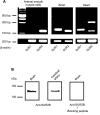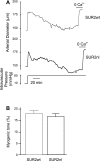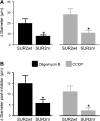Vasodilation induced by oxygen/glucose deprivation is attenuated in cerebral arteries of SUR2 null mice
- PMID: 21784985
- PMCID: PMC3197357
- DOI: 10.1152/ajpheart.00406.2011
Vasodilation induced by oxygen/glucose deprivation is attenuated in cerebral arteries of SUR2 null mice
Abstract
Physiological functions of arterial smooth muscle cell ATP-sensitive K(+) (K(ATP)) channels, which are composed of inwardly rectifying K(+) channel 6.1 and sulfonylurea receptor (SUR)-2 subunits, during metabolic inhibition are unresolved. In the present study, we used a genetic model to investigate the physiological functions of SUR2-containing K(ATP) channels in mediating vasodilation to hypoxia, oxygen and glucose deprivation (OGD) or metabolic inhibition, and functional recovery following these insults. Data indicate that SUR2B is the only SUR isoform expressed in murine cerebral artery smooth muscle cells. Pressurized SUR2 wild-type (SUR2(wt)) and SUR2 null (SUR2(nl)) mouse cerebral arteries developed similar levels of myogenic tone and dilated similarly to hypoxia (<10 mmHg Po(2)). In contrast, vasodilation induced by pinacidil, a K(ATP) channel opener, was ∼71% smaller in SUR2(nl) arteries. Human cerebral arteries also expressed SUR2B, developed myogenic tone, and dilated in response to hypoxia and pinacidil. OGD, oligomycin B (a mitochondrial ATP synthase blocker), and CCCP (a mitochondrial uncoupler) all induced vasodilations that were ∼39-61% smaller in SUR2(nl) than in SUR2(wt) arteries. The restoration of oxygen and glucose following OGD or removal of oligomycin B and CCCP resulted in partial recovery of tone in both SUR2(wt) and SUR2(nl) cerebral arteries. However, SUR(nl) arteries regained ∼60-82% more tone than did SUR2(wt) arteries. These data indicate that SUR2-containing K(ATP) channels are functional molecular targets for OGD, but not hypoxic, vasodilation in cerebral arteries. In addition, OGD activation of SUR2-containing K(ATP) channels may contribute to postischemic loss of myogenic tone.
Figures






Similar articles
-
Hydrogen sulfide dilates cerebral arterioles by activating smooth muscle cell plasma membrane KATP channels.Am J Physiol Heart Circ Physiol. 2011 Jun;300(6):H2088-95. doi: 10.1152/ajpheart.01290.2010. Epub 2011 Mar 18. Am J Physiol Heart Circ Physiol. 2011. PMID: 21421823 Free PMC article.
-
Sulfonylurea receptor-dependent and -independent pathways mediate vasodilation induced by ATP-sensitive K+ channel openers.Mol Pharmacol. 2008 Sep;74(3):736-43. doi: 10.1124/mol.108.048165. Epub 2008 May 29. Mol Pharmacol. 2008. PMID: 18511652 Free PMC article.
-
Characterization of K(ATP)-channels in rat basilar and middle cerebral arteries: studies of vasomotor responses and mRNA expression.Eur J Pharmacol. 2005 Oct 31;523(1-3):109-18. doi: 10.1016/j.ejphar.2005.08.028. Epub 2005 Oct 13. Eur J Pharmacol. 2005. PMID: 16226739
-
K(ATP) channel action in vascular tone regulation: from genetics to diseases.Sheng Li Xue Bao. 2012 Feb 25;64(1):1-13. Sheng Li Xue Bao. 2012. PMID: 22348955 Free PMC article. Review.
-
[Molecular and functional diversity of ATP-sensitive K+ channels: the pathophysiological roles and potential drug targets].Nihon Yakurigaku Zasshi. 2003 Sep;122(3):243-50. doi: 10.1254/fpj.122.243. Nihon Yakurigaku Zasshi. 2003. PMID: 12939542 Review. Japanese.
Cited by
-
Regulation of myometrial contraction by ATP-sensitive potassium (KATP) channel via activation of SUR2B and Kir 6.2 in mouse.J Vet Med Sci. 2016 Aug 1;78(7):1153-9. doi: 10.1292/jvms.15-0700. Epub 2016 Apr 18. J Vet Med Sci. 2016. PMID: 27086859 Free PMC article.
-
Fetal Cerebral Artery Mitochondrion as Target of Prenatal Alcohol Exposure.Int J Environ Res Public Health. 2019 May 7;16(9):1586. doi: 10.3390/ijerph16091586. Int J Environ Res Public Health. 2019. PMID: 31067632 Free PMC article. Review.
-
Smooth Muscle Ion Channels and Regulation of Vascular Tone in Resistance Arteries and Arterioles.Compr Physiol. 2017 Mar 16;7(2):485-581. doi: 10.1002/cphy.c160011. Compr Physiol. 2017. PMID: 28333380 Free PMC article. Review.
-
Interspecies and regional variability of alcohol action on large cerebral arteries: regulation by KCNMB1 proteins.Am J Physiol Regul Integr Comp Physiol. 2023 Apr 1;324(4):R480-R496. doi: 10.1152/ajpregu.00103.2022. Epub 2023 Jan 30. Am J Physiol Regul Integr Comp Physiol. 2023. PMID: 36717168 Free PMC article.
-
Control of neurovascular coupling by ATP-sensitive potassium channels.J Cereb Blood Flow Metab. 2025 Jun;45(6):1130-1143. doi: 10.1177/0271678X251313906. Epub 2025 Jan 17. J Cereb Blood Flow Metab. 2025. PMID: 39819176 Free PMC article.
References
Publication types
MeSH terms
Substances
Grants and funding
LinkOut - more resources
Full Text Sources
Molecular Biology Databases

